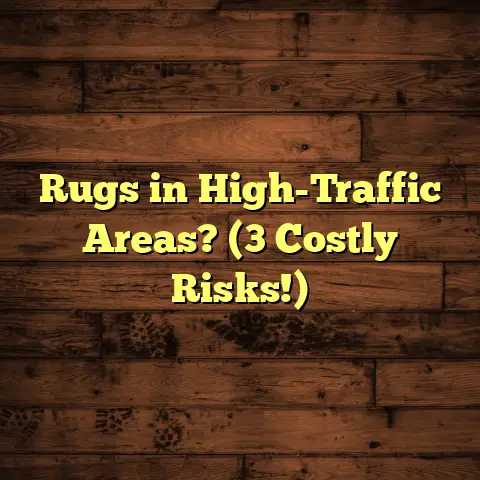Epoxy Garage Floors Worth It? (The ROI # is Shocking!)
We’re living in an era where home design isn’t
just about the living room and kitchen anymore.
People are paying attention to every square
foot, and the garage is no exception.
Think about it: it’s often the first thing you
see when you come home.
It’s a workspace, a
storage area, and, increasingly, a place to
show off your personality.
An appealing garage enhances your property’s
overall value and gives you a sense of pride.
And that’s where epoxy floors come in.
So, are
epoxy garage floors really worth it?
Buckle up, because the ROI might just surprise you!
Section 1: Understanding Epoxy Flooring
So, what is epoxy flooring, anyway?
Simply put, it’s a thermosetting polymer coating
that’s applied over a concrete surface.
It’s made
up of two main components: epoxy resin and a
hardener.
When these two are mixed, they create a
chemical reaction that results in a rigid, durable,
and chemical-resistant finish.
Types of Epoxy Floor Coatings
There’s more than one flavor of epoxy out there.
Here’s a quick rundown of the common types I work
with:
Solid Epoxy: 100% solids, meaning no solvents are added.
This is my go-to for heavy-duty applications.Water-Based Epoxy: Lower in VOCs (volatile organic compounds), making it a more environmentally friendly option.
Good for residential garages.Solvent-Based Epoxy: Known for its excellent adhesion and durability.
Can be trickier to work with due to fumes.Epoxy Mortar: Mixed with aggregates like sand or quartz, creating a super strong, impact- resistant surface.
Perfect for garages that see a lot of abuse.-
Self-Leveling Epoxy: Creates a smooth, seamless surface. Ideal for garages with uneven concrete.
-
Decorative Epoxy: This includes flake, metallic, and quartz epoxy systems. It’s all about aesthetics!
The Installation Process
Okay, let’s talk about how an epoxy floor actually
gets installed.
This isn’t a weekend DIY project
for the faint of heart, trust me.
Here’s the
general process:
Surface Preparation: This is the most important step.
The concrete needs to be thoroughly cleaned, degreased, and any cracks or imperfections need to be repaired.
I often use a concrete grinder to open the pores of the concrete for optimal adhesion.Priming: A primer coat helps the epoxy bond to the concrete.
It’s like putting on a makeup base – it creates a smooth, even surface for the topcoat.-
Epoxy Application: The epoxy mixture is carefully poured and spread evenly using a squeegee or notched trowel.
-
Decorative Add-Ins (Optional): If you’re going for a decorative look, this is where flakes, metallic pigments, or quartz are added.
-
Topcoat (Clear Coat): A clear topcoat protects the epoxy and adds extra durability and shine.
Curing: The epoxy needs time to cure properly.
This can take anywhere from 24 to 72 hours, depending on the type of epoxy and the ambient temperature.
The whole process, from start to finish, typically takes 3-5 days, depending on the size of the garage and the complexity of the job.
Section 2: Benefits of Epoxy Garage Floors
Alright, let’s get to the good stuff: why should you even consider epoxy for your garage?
Durability and Longevity
This is where epoxy really shines.
Epoxy floors
are incredibly durable and can withstand a lot of
abuse.
We’re talking about resisting impacts,
abrasions, and heavy loads without cracking or
chipping.
A properly installed epoxy floor can
easily last 10-20 years or even longer!
Resistance to Stains, Chemicals, and Spills
Garages are magnets for oil spills, road salt,
and all sorts of nasty chemicals.
Epoxy is
virtually impervious to these substances.
Spills wipe up easily, leaving no stains behind.
Say goodbye to that embarrassing oil slick on
your garage floor!
Ease of Cleaning and Maintenance
Cleaning an epoxy floor is a breeze.
Just sweep
or mop with mild soap and water.
No more scrubbing
for hours to remove stubborn stains.
This ease of
maintenance saves you time and effort in the long
run.
Aesthetic Appeal and Customization Options
Gone are the days of boring, gray concrete floors.
Epoxy offers endless customization options.
You
can choose from a wide range of colors, patterns,
and finishes.
Add decorative flakes, metallic
pigments, or even embed logos or designs.
I had a client who was a die-hard car enthusiast
ask me to embed his favorite car logo into the
epoxy floor.
It looked amazing!
Safety Features
Epoxy floors can be made slip-resistant by adding
a non-slip additive to the topcoat.
This is
especially important in garages, where spills and
moisture can create hazardous conditions.
This
slip-resistance helps prevent accidents and injuries.
Section 3: The Cost of Epoxy Garage Floors
Okay, let’s talk about the elephant in the room: the cost.
Installing an epoxy floor is an investment, but it’s important to understand where that money goes.
Cost Breakdown
Here’s a general breakdown of the costs involved:
-
Materials: This includes the epoxy resin, hardener, primer, topcoat, decorative additives (if any), and any necessary tools and equipment.
Expect to pay anywhere from \$2 to \$7 per square foot for the epoxy materials alone.
Labor: This is where a significant portion of the cost comes from.
Professional installation requires skill, experience, and specialized equipment.Labor costs can range from \$3 to \$8 per square foot, depending on the complexity of the job and the location.
Surface Preparation: As I mentioned earlier, proper surface preparation is crucial.
This can include cleaning, grinding, patching cracks, and repairing any damage to the concrete.Surface preparation can add an extra \$1 to \$3 per square foot to the overall cost.
-
Additional Expenses: Don’t forget about potential additional expenses, such as moving items out of the garage, disposing of old flooring materials, and any unforeseen repairs that may be needed.
Comparing Costs
Let’s compare epoxy to some other common garage flooring options:
As you can see, epoxy is generally more expensive
than concrete sealants or vinyl flooring, but it
offers superior durability, longevity, and
aesthetic appeal.
Tiles can be comparable in
cost, but they can be more prone to cracking and
require more maintenance.
Factors Affecting Cost
Several factors can affect the overall cost of your epoxy garage floor:
-
Garage Size: Obviously, the larger the garage, the more materials and labor will be required.
-
Condition of the Concrete: If your concrete is in poor condition, it will require more extensive preparation, which will increase the cost.
Type of Epoxy: Different types of epoxy have different price points.
Solid epoxy is generally more expensive than water-based epoxy.-
Decorative Options: Adding decorative flakes, metallic pigments, or custom designs will increase the cost.
-
Location: Labor costs can vary depending on your location.
Section 4: Return on Investment (ROI) Analysis
Now, let’s get to the really interesting part: the return on investment (ROI).
ROI in Home Renovations
ROI is a measure of how much you’ll get back from
a home renovation project compared to how much you
spent on it.
It’s a crucial factor to consider
when making any home improvement decision.
Increasing Home Value
So, how can epoxy garage floors increase your home’s
value?
Well, several studies have shown that a
well-maintained and aesthetically pleasing garage
can significantly boost your property’s appeal to
potential buyers.
According to a recent survey by the National
Association of Realtors (NAR), 80% of home buyers
said that the garage was an important factor in
their decision-making process.
A finished garage,
including epoxy flooring, can add as much as 5% to
your home’s overall value.
Let’s say your home is worth \$400,000.
A 5%
increase would add \$20,000 to its value.
If you
spent \$4,000 on an epoxy garage floor, your ROI
would be a whopping 400%!
Case Studies and Testimonials
I’ve seen this firsthand with my clients.
I
remember one client in particular, Sarah, who was
selling her house.
She had a dated, unfinished
garage.
I convinced her to invest in an epoxy
floor, and she was hesitant at first.
But after the installation, she was blown away by
the transformation.
Her garage went from an
eyesore to a selling point.
She ended up getting
multiple offers on her house and sold it for
\$15,000 more than she expected.
Market Trends
The trend towards finished garages is only
growing.
Homeowners are increasingly viewing the
garage as an extension of their living space, not
just a place to park their cars.
Investing in an
epoxy garage floor is a smart way to tap into
this trend and appeal to a wider range of
potential buyers.
Section 5: Long-Term Value
The benefits of epoxy flooring extend far beyond the initial ROI.
Reduced Maintenance Costs
As I mentioned earlier, epoxy floors are incredibly
easy to clean and maintain.
This translates to
lower maintenance costs over the long term.
You
won’t need to spend money on expensive cleaning
products or hire professional cleaners.
Longevity
Epoxy floors are built to last.
With proper care
and maintenance, they can withstand heavy use and
last for decades.
This means you won’t have to
worry about replacing your garage flooring anytime
soon.
Impact on Energy Efficiency
Epoxy floors can also improve your garage’s energy
efficiency.
The reflective surface of epoxy can
help brighten up the space, reducing the need for
additional lighting.
This can save you money on
your electricity bill.
Organized and Usable Space
A finished garage with an epoxy floor is a more
organized and usable space.
It’s easier to keep
clean and tidy, and it provides a comfortable
surface for working on projects or hobbies.
This
can improve your overall quality of life.
Section 6: Common Myths and Misconceptions
Let’s bust some common myths about epoxy garage floors:
Durability and Maintenance
-
Myth: Epoxy floors are easily damaged and require a lot of maintenance.
Reality: Epoxy floors are incredibly durable and require minimal maintenance.
They’re resistant to stains, chemicals, and abrasions.
Aesthetics
-
Myth: Epoxy floors are only for industrial settings and look sterile and uninviting.
Reality: Epoxy floors come in a wide range of colors, patterns, and finishes.
You can create a custom look that complements your home’s style.
Installation
-
Myth: Epoxy floor installation is complicated and prone to problems.
-
Reality: While professional installation is recommended, a skilled contractor can ensure a smooth and successful installation.
Section 7: Conclusion
So, are epoxy garage floors worth it?
Absolutely!
The ROI is shocking, and the aesthetic and
functional benefits are undeniable.
From
increased home value to reduced maintenance
costs, epoxy flooring is a smart investment for
any homeowner.
Don’t overlook your garage.
It’s a valuable space
that can significantly impact your home’s value
and usability.
Call to Action:
Ready to transform your garage?
Contact me today
for a free consultation and let’s explore the
possibilities of epoxy flooring!





